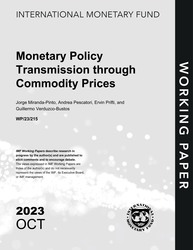
Monetary Policy Transmission through Commodity Prices
Monetary Policy Transmission through Commodity Prices
READ MORE...
Volume/Issue:
Volume 2023
Issue 215
Publication date: October 2023
ISBN: 9798400256691
$20.00
Add to Cart by clicking price of the language and format you'd like to purchase
Available Languages and Formats
| English |
Prices in red indicate formats that are not yet available but are forthcoming.
Topics covered in this book
This title contains information about the following subjects.
Click on a subject if you would like to see other titles with the same subjects.
Inflation , Economics- Macroeconomics , Economics / General , Monetary Policy , US monetary policy shock , ECB monetary policy shock , Commodity prices , commodity price channel , inflation , energy prices , food prices , metals prices , core inflation , commodity-price channel , inflation dynamics , channel of monetary policy , monetary policy shock , Metal prices , Oil prices , Global
Summary
Monetary policy influences inflation dynamics by exerting impact on a diverse array of commodity prices. At high frequencies, we show that a 10 basis points increase in US monetary policy rate reduces commodity prices between 0.5% and 2.5%, after 18 to 24 business days. Beyond the dollar appreciation channel, the effects are larger for highly storable and industrial commodities, consistent with the cost of carry and the expected demand channel. We then study the quantitative importance of the commodity-price channel of monetary policy on domestic and international inflation at longer horizons (6-36 months). The results indicate that the response of commodity prices—oil, base metals, and food prices—to monetary policy accounts for 47% of the total effect of US monetary policy on US headline inflation, and 57% of the effect of US monetary policy on other countries’ headline inflation. The commodity price channel on core inflation is smaller and mainly driven by base metal prices. Finally, the commodity-price channel of ECB monetary policy is smaller, and it mainly operates through its effect on energy prices.
Copyright © 2010 - 2025
Powered by:
AIDC



